7 Steps for a Perfect Fall Cleanup
7 Steps for a Perfect Fall Cleanup
Now that a chill is definitely in the air, you’re probably torn between staying inside this weekend to watch the game or getting your butt in gear and taking care of some chores in the yard.
I know, I know, it seems its hardly a fair choice to make but something has to be done. So in between the commercial breaks and halftime show, I’ve put together a do-it-yourselfer list of tasks that need to

be done to your yard for your fall cleanup.
1. Trimming Back Bushes and Perennials
Now that fall has firmly taken its grip here in Bend, all of your flowering perennials from last summer should have finally succombed to the frosts. Those that haven’t, well, sadly their time has come.
Take a pair of hand pruners or electric shears if you have them and cut back the foliage nearly to the ground.
Things like daisies, black-eye Susans, cat mint, gaillardia, coreopsis, aster, phlox, and the like, can all be cut down to the ground.
A couple of perennials you won’t want to cut to the ground are: lavender, Caryopteris, and your Carl Forester ornamental grasses. Lavender and caryopteris both need to be trimmed back against the “woody” material of the plant. Carl forester, I recommend trimming back to about 10 inches in height. You can flat top it or round it over.
Its super important to trim back your ornamental grasses every year during your fall cleanup because they will get thatchy just like your lawn does.
Here’s cool trick for trimming your tall grasses and not making such a mess:
- Grab a bungee cord
- Wrap around the grass a few times until snug
- Secure in place
- Trim your grass
Once trimmed, you can take the bundle of grass to your debris back and drop it in. Almost no mess!
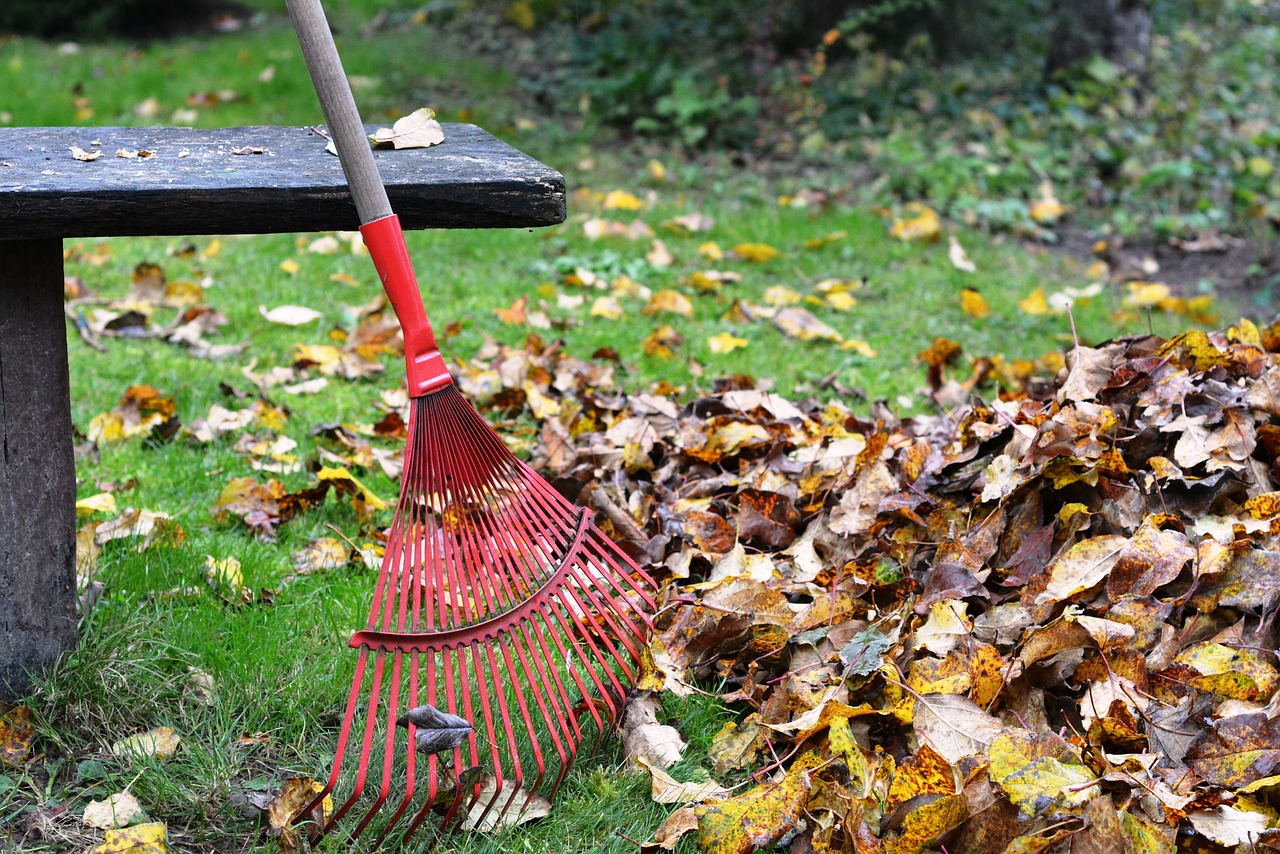
2. Rake Out Your Beds
I suppose it goes without saying, but the main part of the fall cleanup is raking up all the debris, after all. You just want to wait to do it until after you have all your flowers and bushes pruned back, that way you’re not doing it twice.
I like raking the debris out onto the lawn. Some people like putting it on a tarp. That’s fine, just make sure you don’t leave your tarp for long or it could damage your grass even though its mostly dormant.
3. Rake Out the Lawn
Make sure you get the lawn. If you leave leaves and pine needles on your lawn all winter, it can actually do a lot of damage to your grass.
I know there are a lot of blogs out there that insist that removing debris in the fall is a gardening sin, and in milder climates with longer growing seasons, its probably ok to let some things decompose over the winter.
But in Bend, where the growing season is officially only 90 days long, that’s just not enough time for nature to work its decompositional magic on the sheer volume of all that debris.
Leaves left in piles on the lawn will eventually rot – which is not the same as decomposing – leading to mold and fungus growth in the turf, which can take a lot of time to recover from in the spring.
Pine needles, as I discussed in a previous blog, leave their sap behind, which is acidic. Over time, and it only takes two or three seasons of this, it will negatively alter the pH of your soil, making it impossible for your lawn to absorb the nutrients it needs to grow strong and look healthy.
4. Control Weeds
I don’t know what it is about these things, but even though its freezing cold and every plant with some sense has hibernated, weeds still like to grow. There are probably a few that have popped up in your beds since the last time you did a good weeding back in September/October.
Now is a good time to get these yanked out and tossed on your debris piles you made in the lawn right next to the flower beds.
The best way to do this is by using a cool tool I like to call a hula hoe. I don’t now where that name comes from because it’s actually called a scuffle hoe. It’s a very simple and essential gardening tool that allows you to quickly scrape the ground and rip all the weeds out. No sore fingers from grabbing and pulling all afternoon. In a matter of minutes, you can turn over all your beds, provided they aren’t filled with matted grass and overgrown weeds. This is for routine maintenance of ongoing weed control.
I’m usually not a fan of chemicals, but they do have their place. Because of the nature of our local climate and the propensity for weeds to grow continuously through the fall, I do recommend applying a mild pre-emergent to your beds after they have been weeded and raked out.


Hula Hoe
DO NOT USE CASARON. Its kinda sold as a pre-emergent, but it’s not. It’s a post application, water activated, broad spectrum herbicide, meaning that it’s designed to kill whatever gets in its path, regardless of how established it is.
It also trans locates, meaning if you sprinkle it on top of a berm next to your lawn, there’s a good chance your lawn will be dead in spring because it ran down the berm and collected at the bottom where the lawn is.
True pre-emergents are selective herbicides meaning they are intended to target newly germinating seeds by creating a toxic barrier that inhibits germination or growth of a new sprout. Unless you way over apply it, it won’t harm nearby, established plants.
Don’t put pre-emergents anywhere you may have planted fall bulbs as it could harm the new bulb.
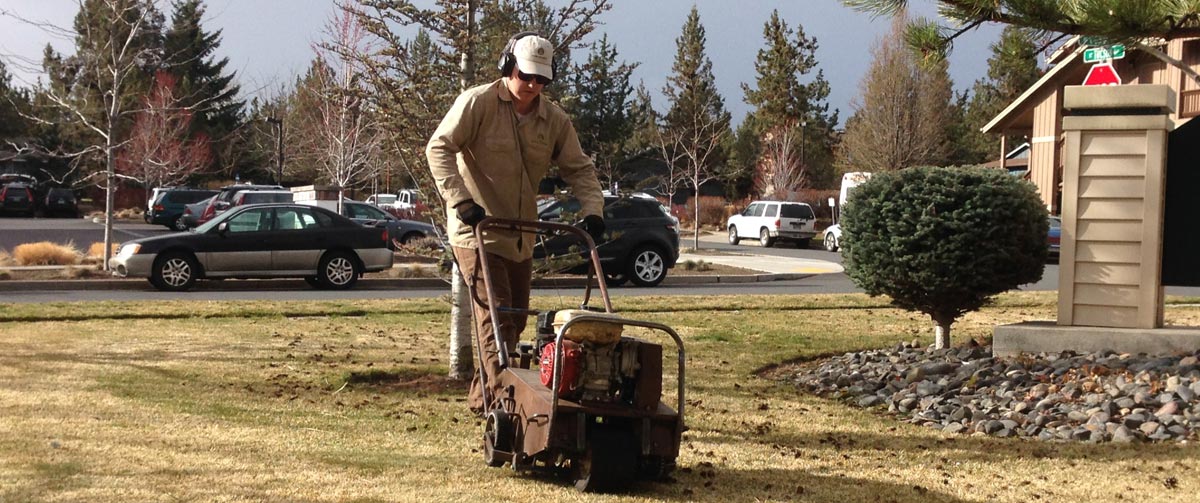
5. Aerate the Lawn
Aerating your lawn is a quick and easy step in your fall cleanup and yard prep. You can rent an aerator from most rental yards around town, and if your only vehicle is a Prius, don’t worry, a lot of them deliver and pickup for you.
Aerating loosens the soil, which is super important for our hard packed soils in Bend. It opens the soil so air can mix readily with the dirt and roots, exchanging valuable atmospheric gasses. It also allows nutrients from fertilizer to go directly into the roots.
What about all the “dog poo?”
Some people complain about the cores or plugs the aerator leaves behind because it kinda gives Fido a bad reputation. You can leave the cores if you want, it’s technically better if you do.
But for those of you who demand neatness and perfection, you can usually easily collect most of the plugs in the next step.
6. Doing the Final Mow
Now that your beds are in order, and all your debris piles have been collected, it’s time to get your mower out one last time to put the final cut on your lawn for the season.
This is a really important step in the fall cleanup process as it provides a couple key benefits for your lawn.
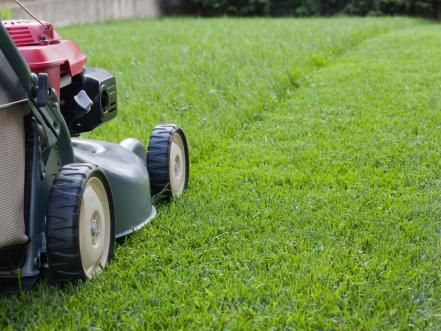
Thatch is a condition where, through the natural cycle of turf growth, dead grass accumulates on the ground, eventually choking the roots.
Every year, when your lawn turns green in the spring, most of that is because of brand new leaf growth, not last year’s grass turning green again.
The second great benefit it provides is by removing all the unnecessary top growth, it opens up the ground to receive more atmospheric nitrogen, which comes with rain and snowfall over the course of the winter. We want that to go strait into the soil.
Cutting the lawn short – not to be confused with scalping your lawn – so if you normally cut your lawn 2 inches tall, make your final cut at an inch and a half.
You’ll probably be surprised how long it takes you to mow because in addition to cutting off a half inch of grass, you’ll also be cutting into the lawn’s thatch layer. So don’t be surprised if you need to make a couple passes to get it down to the height you want it at.
Mowing Tip: don’t set your mowing height adjusters all at the same level. You need to angle your blade. If you make it level, especially when you are doing your final cut, it will actually just leave a bunch of swirlies in your lawn. Instead, make one complete pass over your lawn with the front adjusted down to 1.5 inches, and the back up at 1.75 or 2 inches.
On your second pass, drop all the adjusters down another notch to the desired finished height.
This will leave your lawn stripped and tight for the long winter ahead. It also cleans up where your raked your debris piles onto the lawn during bed clean out.
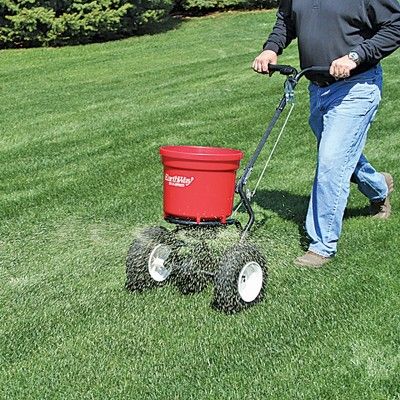
7. Fall Fertilizer
So, I’ve been reading some blogs out there that look like they were written by someone whose never seen grass before.
Beware the quality of the content you read from other blogs. This one said, “Be sure to apply a high nitrogen, fast release fertilizer to your lawn because it will stimulate the roots to grow.”
YIKES! Run! No!!!! A high nitrogen, fast release fertilizer is the worst thing you could put on your lawn and the reason is this: nitrogen stimulates leaf growth, not root growth, and why would you want to do that with winter right around the corner?
The truth is, you really want to be able to feed your roots and build immunity in your turf. You should be fertilizing with a high quality, phosphorus/potassium heavy mix with little or no nitrogen.
Simplot makes a great fertilizer just for this purpose. In fact, Simplot is arguably the Cadillac of fertilizers, especially when it comes to their homogenous blends (that means every pellet has the same nutrient composition unlike cheap fertilizers you get from the box store), dust free pellet.
I should probably also point out, I am not compensated to say that. We use Simplot Fertilizers and are very happy with the results we get from them.
You’ll have to go to a specialty supplier like Ewing Irrigation in order to pick that up.
8. Bonus Tip!
Because I know you were looking for one more thing to do…but seriously, if you’ve put off the game this long, you might as well go for a homerun with your yard.
Now that you’ve cleaned everything up, trimmed back all your plants, raked the leaves and pine needles, done the final mowing, and put your fall fertilizer down, there’s one more
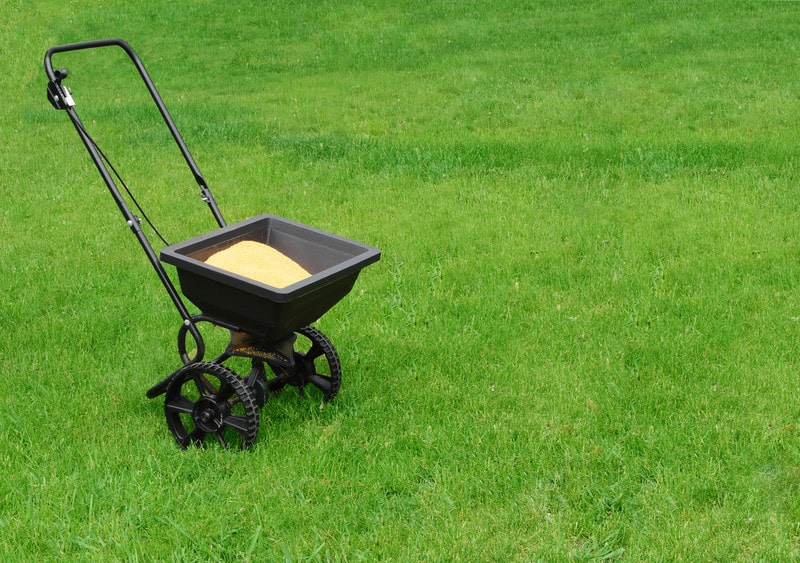
task you need to do to make your fall cleanup complete: Over seed the lawn.
You could also do this in spring, but my preference is to do it in the fall. The reason is, we never know what kind of winter we are going to get. And on the off chance we get one of those strange, mild winters, its good to get seed down in fall, so it can germinate naturally at the earliest possible moment in spring.
While there are some people who have fescue lawns in Central Oregon, Kentucky Bluegrass is the dominant type. If you don’t know your type, just assume its bluegrass (because it won’t matter either way).
Grab a bag of pure bluegrass seed. You don’t need a rye/fescue/bluegrass mix. Those are for starting lawns from scratch. You need a pure seed blend that you can just throw lightly over the top of your lawn.
Why is this important? Well, think about it this way…dogs and cats are generally cuter when they are puppies and kittens, right? As it turns out…so is your lawn.
As a lawn ages, it looses some of its vitality. Keeping a constant flow of new grass coming into your lawn keeps it vigorous, thick, and healthy.
Applying seed isn’t rocket science. On my small lawn, I just get a couple pounds of seed and toss it around by hand. If you have a 2,000 square foot lawn, 5 pounds should be plenty of seed.
Skip the box store and run over to a local provider like Instant Landscaping to get your seed. They work directly with McPheeters, who is the largest supplier of sod in the Central Oregon area. You’ll get the best seed because it was meant to be used on our region.
7 Steps for a Perfect Fall Cleanup
Not Interested in Cleaning Your Yard Yourself?
We Can Help With That.
Let’s work together to make your yard look awesome!
